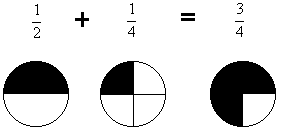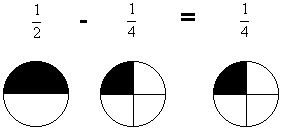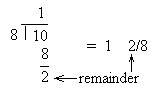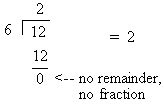Name:_________________Parent:____________________Points:_________
UNIT 6: FRACTION ADDITION - DIFFERENT DENOMINATORS (PART 1)
To add fractions with different denominators, you must first change both denominators to be the same.
The denominator will be the LARGER of the 2 denominators. |
EXAMPLES:

 | | To do this you will need the skills you learned in Unit 5. Once you have both denominators the same, then you just add the numerators. If the denominator of one fraction divides evenly (no remainder) into the other, then change the fraction with the smaller denominator to a fraction with the larger denominator, then add numerators. |
Add these fractions: (I will give you the first 3 common denominators!)
| 13) |
 |
14) |
 |
15) |
 |
These 3 problems are hard!
Name:_________________Parent:____________________Points:_________
UNIT 7: FRACTION ADDITION - DIFFERENT DENOMINATORS (PART 2)
To add fractions with different denominators, you must first change both denominators to be the same. To do this you will need the skills you learned in Unit 5. Once you have both denominators the same, then you just add the numerators. Sometimes one denominator does not divide evenly into the other, as they did in Unit 6. In this case you must change BOTH denominators into a number that both original denominators will divide into evenly.
An easy way to find this new denominator
is to multiply the 2 original denominators
together to get your new one!
|
EXAMPLES:
|

2 does not divide evenly into 3,
so make your new denominator
2 X 3 = 6
 |

3 does not divide evenly into 4,
so make your new denominator
4 X 3 = 12
 |
|
Add these fractions:
(I will give you the first 3 common denominators!)
| 22) |
 |
| |
|
Name:_________________Parent:____________________Points:_________
UNIT 8: FACTORING
To 'factor' a number means to break it up into numbers that can be multiplied together
to get the original number.
EXAMPLES:
|
|
6 = 3 X 2 <== The factors of 6 are 3 and 2
9 = 3 X 3 <== The factors of 9 are 3 and 3
|
Sometimes, numbers can be factored
into different combinations.
For example:
8 = 4 X 2 and 2 X 2 X 2
Two different ways to factor:
How about 18? 18 = 9 X 2 or 6 X 3
|
|
Factor the following numbers. I will factor the first one for you!
| 1) |
10 = 5 X 2
|
2) |
15 =
|
3) |
20 =
|
| 10) |
27 = |
11) |
25 = |
12) |
30 = |
| 13) |
28 = |
14) |
50 = |
15) |
33 = |
| 16) |
34 = |
17) |
70 = |
18) |
46 = |
| 19) |
39 = |
20) |
This problem is hard!
169 = |
21) |
This problem is hard!
95 = |
| 22) |
This problem is hard!
221 = |
| |
|
Name:_________________Parent:____________________Points:_________
UNIT 9: FRACTIONS - REDUCING TO LOWEST TERMS
Sometimes the numerator of a fraction will divide evenly into the denominator. The fraction can be reduced by replacing the numerator with a 1 and dividing the original denominator by the numerator to get a new denominator.
|
EXAMPLES:
|

|
because 4/2 = 2
|

|
because 6/2 = 3 |
Fractions in which the numerator and denominator contain the same factor can also be reduced by removing the common factor from both the numerator and the denominator.
|
EXAMPLES:
|

|
|
The 3s cancel because they
are in both the numerator and
the denominator, and you get 2/3 |
 |
|
The 7s cancel and you get:
3/4
|
|
Reduce these fractions to their lowest terms:
(I will give you the common factors for the first 3 problems!)
| 1) |

(common factor is 5) |
2) |

(common factor is 6) |
3) |

(common factor is 4) |
| 25) |
 |
26) |
This problem is hard! |
 |
| |
|
Name:_________________Parent:____________________Points:_________
UNIT 10: FRACTIONS - MIXED NUMBERS
A fraction in which the numerator is larger than the denominator is called an .
These are improper fractions:
Fractions like these can be turned into . A mixed number is a whole number with a fraction added to it. You turn an improper fraction into a mixed number by dividing the numerator by the denominator and making a fraction that goes with it (if there is one) by putting the remainder over the denominator.
The above improper fractions change into mixed numbers by dividing the numerator by the denominator, like this:
|
Turn these improper fractions into mixed numbers:
| 1) |

Hint: 8 goes into 20 how many times? ___
What is left over? ___ |
2) |
 |
3) |
 |
| 16) |
 |
17) |
This problem is hard!
 |
18) |
This problem is hard!
 |
|
Name:_________________Parent:____________________Points:_________
UNIT 11: FRACTIONS - MULTIPLYING MIXED NUMBERS
To multiply mixed numbers by any other number (fraction, whole number or another mixed number) you must first convert the mixed number to an
To convert a mixed number to an improper fraction, you multiply the denominator by the whole number and then add the numerator to get your new numerator. The denominator stays the same. This is just the opposite of what we did in unit 10.
Here's how to think about this:
- Take the first mixed number: 5 1/8th.
- How many 8ths are there in 5? There are 40 of them.
(Each whole number has 8 8ths.)
- Add 1 to get 41/8ths.
WARNING: IT DOESN'T WORK
TO JUST
MULTIPLY THE WHOLE NUMBERS
AND THE FRACTIONS SEPARATELY! |

|
 |
|
Multiply the following: (I will convert the first mixed number for you!)
| 1) |

Note: the 2 becomes 2/1 as a fraction
|
| 2) |

|
3) |
 |
| 4) |
 |
5) |
 |
| 6) |
 |
7) |
 |
| 8) |
 |
9) |
 |
| 10) |
 |
11) |
This problem is hard!
 |
|
Name:_________________Parent:____________________Points:_________
UNIT 12: INTRODUCTION TO DECIMALS
are numbers that contain a decimal point, like:
The number to the left of the decimal point is an integer (positive or negative whole number or zero).
The number to the right of the decimal is called the "tenths" digit and tells you the number of tenths (1/10's) that are added to the whole number to the left of the decimal point.
So...
1.5 is the same
as the mixed number |
 |
2.8 is |
 |
.2 is |
 |
If there are 2 numbers to the right of the decimal point then both numbers to the right of the decimal point are the number of "hundredths" (1/100's) to be added to the whole number, so.....
| 3.14 is the same as the mixed number |
 |
|
66.66 is the same
as the mixed number |
 |
|
Convert these decimals to :
| 1) |
1.6 =
|
2) |
2.9 =
|
3) |
14.4 =
|
4) |
16.17 = |
5) |
22.88 = |
6) |
This problem is hard!
1.04 = |
Convert these mixed numbers to decimals: |
| 7) |
 | 8) |
 |
9) |
 |
|
| 10) |
 |
11) |
 |
12) |
This problem is hard!
 |
|
Name:_________________Parent:____________________Points:_________
UNIT 13: DECIMAL ADDITION
To add decimals, you must write one above the other with their decimal points lined up, like this:

Where one decimal doesn't have digits that the other one does, you put in zeroes, like this:

Now, its easy! You just add the two numbers as you would two whole numbers, with carries if necessary, but you keep track of where the decimal point goes and put it in the result right under the decimal points in the two numbers being added, like this:

|
Add these decimals: (I will line up the first decimal for you!)
| 1) |

|
2) |
4.4 + 8.8
|
| 3) |
9.09 + .2
|
4) |
16. + 1.05 |
| 5) |
.3 + 1.55 |
6) |
This problem is hard!
9.99 + 100.99 |
|
Name: _______________________________ Parent:_____________________ Points: ________
UNIT 14: DECIMAL SUBTRACTION
Decimal subtraction is similar to decimal addition. You
write down both decimals one above the other with their decimal points lined up. Then you just substract as you would 2 whole numbers, with borrows if necessary, but you bring down the decimal point like you did with decimal addition.
EXAMPLES:
23.06
- 14.07
8.99
|
1.44
- 0.06
1.38
|
2.3
- 0.8
1.5
|
|
Subtract these decimals: (Allow me to line up the first one!)
| 1) |
2.3 - 1.1 =

|
2) |
44.2 - .2
|
| 3) |
9.31 - 1.2
|
4) |
6.66 - 4.48 |
| 5) |
16.23 - 1.4 |
6) |
1.06 - .1 |
| 7) |
144.2 - 128.3 |
8) |
29 - 1.4 |
| 9) |
14.4 - 13.9 |
10) |
18.1 - 1.44 |
| 11) |
32.6 - 2.88 |
12) |
This problem is hard!
.228 - .01 |
|
Name: _______________________________ Parent:______________________ Points: ________
UNIT 15: DECIMAL MULTIPLICATION
To multiply 2 decimals, you merely multiply the 2
numbers
together, ignoring the decimal points.
Then, when you have your answer (called the "product"), you add the number of digits to the right of the decimal point in each number together
and place the decimal in your answer (product) that many
places from the RIGHT.
YOU DON'T LINE UP THE DECIMAL
POINTS!
EXAMPLES:


|
Multiply these decimals (don't use your calculator and DON'T LINE UP THE DECIMAL POINTS!):
1)

|
2)
 |
3)
 |
4)

|
5)

| 6)

|
7)
 |
8)
 |
9) This problem is hard!
 |
|
Name: _______________________________ Parent:______________________ Points: ________
UNIT 16: DECIMAL DIVISION
Here's how you divide one decimal by another:
Suppose you want to divide 4.5 by 1.8
First, you write your problem as you normally would:
 Next, you move the decimals in both the numbers to the right the
same number of times until the divisor is a whole number.
Next, you move the decimals in both the numbers to the right the
same number of times until the divisor is a whole number.
 The decimal point in your answer will be lined up with the one in
the number you are dividing into. Now, you do your division:
The decimal point in your answer will be lined up with the one in
the number you are dividing into. Now, you do your division:
 Next, if you have a remainder, bring down a zero from the number being divided and continue:
Next, if you have a remainder, bring down a zero from the number being divided and continue:
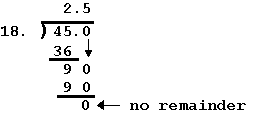 Check your answer for reasonableness by ignoring the part past the decimal and dividing in your head! For example, in this last problem 45/18 is about 2 so the answer should be near 2.
Check your answer for reasonableness by ignoring the part past the decimal and dividing in your head! For example, in this last problem 45/18 is about 2 so the answer should be near 2.
|
Divide these decimals: (These problems are all hard but don't use your calculator!)
Congratulations! You have finished!
|
|

